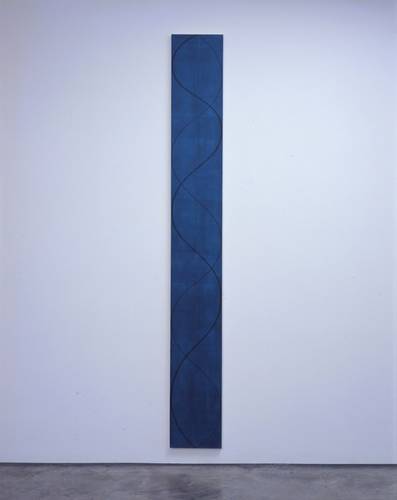Robert Mangold
17 Mar - 30 Apr 2005
Robert Mangold
17th March – 30th April 2005
Robert Mangold is one of the most pre-eminent artists of his generation.
Since the 1960s he has developed an artistic vocabulary derived from the
idea of geometry and asymmetry in shape and form. Mangold's use
of subtle colour and curvilinear abstract forms are associated with
Minimalism but also recall other sources from Ancient Greek pottery to Renaissance frescoes.
With the Column Painting series, Robert Mangold has created a body of work with an elegant economy of means, rich in interrelationships. He overturns the traditional orientation of painting on the horizontal plane and instead emphasises the vertical, so that the canvases evoke architectural elements, the simplicity of which belies a careful conceptual structure.
The pencil lines over washes of colour and the sinuous multiple rhythms of reverse curves are visually seductive. The drawn curves suggest the sensation of kinetic movement or even the visual translation of a sound wave. These hand drawn curves and under-drawing are important elements in Mangold’s work and provide each painting with a clear structure. Each series of curves has been plotted out on a separate grid, each grid made up of sections mirroring the one adjacent with geometric exactitude. The pencilled grids themselves form a subtext, giving the paintings an ordering principle and simultaneously denying the implicit illusionism of the curves.
There is a contrast between the precision of the geometric progressions and the lyricism and beauty of the curves and subtle colour of the paintings that gives them a rigorous conceptual basis. These gestalt images contain the method and trace of their making; the process of the facture is made transparent.
Born in 1937 in North Tonawanda, New York, Mangold lives and works in Washingtonville, New York.
Since his first one-person exhibition in 1964, Mangold’s work has been exhibited extensively worldwide, including solo exhibitions at Solomon R. Guggenheim Museum New York, 1971; Kunsthalle Basel, 1977 and Stedelijk Museum, Amsterdam. His work has been included three times in both Documenta, Kassel (1972, 1977, 1982) and in the Whitney Museum of American Art Biennial (1979, 1983, 1985). Mangold has also been exhibited in the Venice Biennale in 1993. The first part of Mangold’s catalogue raisonné exists in two parts, the first in 1982, and the second in 1998-99.
Robert Mangold’s work is found in many prestigious collections including: The Art Institute of Chicago, Fundacío La Caixa, Barcelona; the Hirshhorn Museum, Washington; The J. Paul Getty Trust, California; Kunstmuseum Basel, Switzerland; The Los Angeles County Museum of Art, the Museo Nacional de Arte Reina Sofia, Madrid; The Museum of Modern Art, New York; the San Francisco Museum of Modern Art; the Solomon R. Guggenheim, New York; the Stedelijk Museum, Amsterdam; the Tokyo Metropolitan Art Museum and the Whitney Museum of American Art, New York.
17th March – 30th April 2005
Robert Mangold is one of the most pre-eminent artists of his generation.
Since the 1960s he has developed an artistic vocabulary derived from the
idea of geometry and asymmetry in shape and form. Mangold's use
of subtle colour and curvilinear abstract forms are associated with
Minimalism but also recall other sources from Ancient Greek pottery to Renaissance frescoes.
With the Column Painting series, Robert Mangold has created a body of work with an elegant economy of means, rich in interrelationships. He overturns the traditional orientation of painting on the horizontal plane and instead emphasises the vertical, so that the canvases evoke architectural elements, the simplicity of which belies a careful conceptual structure.
The pencil lines over washes of colour and the sinuous multiple rhythms of reverse curves are visually seductive. The drawn curves suggest the sensation of kinetic movement or even the visual translation of a sound wave. These hand drawn curves and under-drawing are important elements in Mangold’s work and provide each painting with a clear structure. Each series of curves has been plotted out on a separate grid, each grid made up of sections mirroring the one adjacent with geometric exactitude. The pencilled grids themselves form a subtext, giving the paintings an ordering principle and simultaneously denying the implicit illusionism of the curves.
There is a contrast between the precision of the geometric progressions and the lyricism and beauty of the curves and subtle colour of the paintings that gives them a rigorous conceptual basis. These gestalt images contain the method and trace of their making; the process of the facture is made transparent.
Born in 1937 in North Tonawanda, New York, Mangold lives and works in Washingtonville, New York.
Since his first one-person exhibition in 1964, Mangold’s work has been exhibited extensively worldwide, including solo exhibitions at Solomon R. Guggenheim Museum New York, 1971; Kunsthalle Basel, 1977 and Stedelijk Museum, Amsterdam. His work has been included three times in both Documenta, Kassel (1972, 1977, 1982) and in the Whitney Museum of American Art Biennial (1979, 1983, 1985). Mangold has also been exhibited in the Venice Biennale in 1993. The first part of Mangold’s catalogue raisonné exists in two parts, the first in 1982, and the second in 1998-99.
Robert Mangold’s work is found in many prestigious collections including: The Art Institute of Chicago, Fundacío La Caixa, Barcelona; the Hirshhorn Museum, Washington; The J. Paul Getty Trust, California; Kunstmuseum Basel, Switzerland; The Los Angeles County Museum of Art, the Museo Nacional de Arte Reina Sofia, Madrid; The Museum of Modern Art, New York; the San Francisco Museum of Modern Art; the Solomon R. Guggenheim, New York; the Stedelijk Museum, Amsterdam; the Tokyo Metropolitan Art Museum and the Whitney Museum of American Art, New York.

